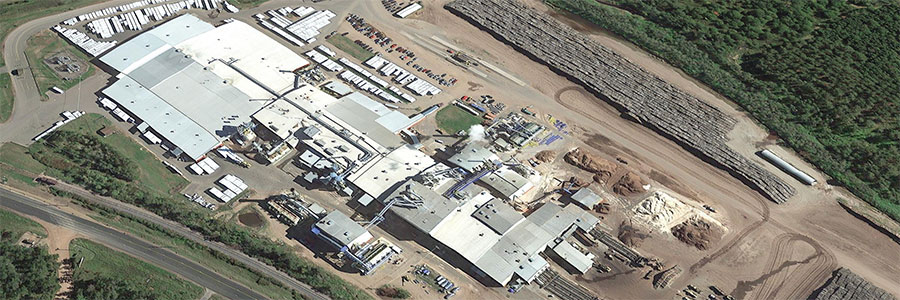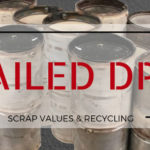As with any manufacturing facility, equipment and/or entire plants eventually become obsolete, requiring upgrades, replacement, or decommissioning. This often means the dismantling or demolition of facilities that include equipment containing high-value platinum group metals (PGM). This case study features a project where high-value industrial catalyst materials containing PGM were recycled in lieu of disposing of them as simple scrap material.
Key Takeaways
- For plant owners operating Regenerative Catalytic Oxidizers (RCO), working with an experienced PGM recycling partner is an excellent option to help maximize the value of recyclable materials during equipment replacement or plant closures.
- Compared to paying for the disposal of valuable catalyzed material, recycling can generate meaningful returns for plant owners.
Objectives for the Plant Owner
The plant owner was dismantling an old RCO because it was being replaced by a new RCO in a different part of the plant. Because this only occurs every 15-20 years, many plant owners have limited experience with the removal and reclamation of catalyzed materials used in RCO equipment. In this case, the plant owner was looking for the following:
- An experienced PGM recycling partner who could tailor their services to the unique needs of this project.
- A recycling partner who could identify, test, quantify and remove the material, both catalyzed and non-catalyzed, at breakeven or netting a small profit.
- A recycling partner who could handle the logistics of removing the material so it could be separated, screened, packaged, and shipped for processing at a reasonable return.
Services provided by Red Fox Resources
Although PGM recycling projects have similar steps, most have unique aspects related to the equipment, location, logistics, and materials involved. Listed below is a summary of services provided on this project.
- Identify and test the various materials to determine what was catalyzed and what was not catalyzed.
- Provide a pro forma estimate of costs and payouts based on certain projections or assumptions following the initial assessment and material testing.
- Some materials had no or light catalyst loading, which added risk to the project in terms of added handling costs and fees during processing.
- Coordinate with a local contractor to remove the material from the RCO with a large industrial vacuum.
- Build an onsite screening system to sort and separate the catalyzed material from the non-catalyzed material to minimize added costs and maximize payouts.
- Coordinate logistics to have the materials transported from the plant for processing.
- Package and process the catalyzed media so it can be shipped from the plant to several processing facilities.
- Dispose of the non-catalyzed material (certain saddles and rings) that would not be recycled.
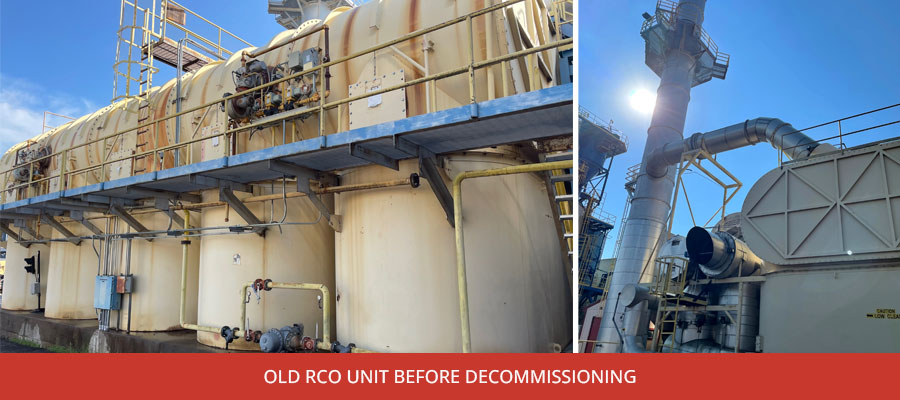
What type of manufacturing facility did this project involve?
This facility is located in the Upper Midwest (U.S.) and produces a variety of wood siding products. The plant owner was decommissioning one of three (3) Regenerative Catalytic Oxidizers (RCO) at the site because it had reached the end of its useful life and was being replaced by a new RCO unit.
This RCO is a packed reactor that utilizes extruded VOCat catalyst packing material manufactured by BASF. Two different types of VOCat were present in the unit, the RCO 5000 product, which is supplied in the form of saddles, and the RCO 7000 type catalyst, which is manufactured in the shape of rings and had been in operation since 2009.
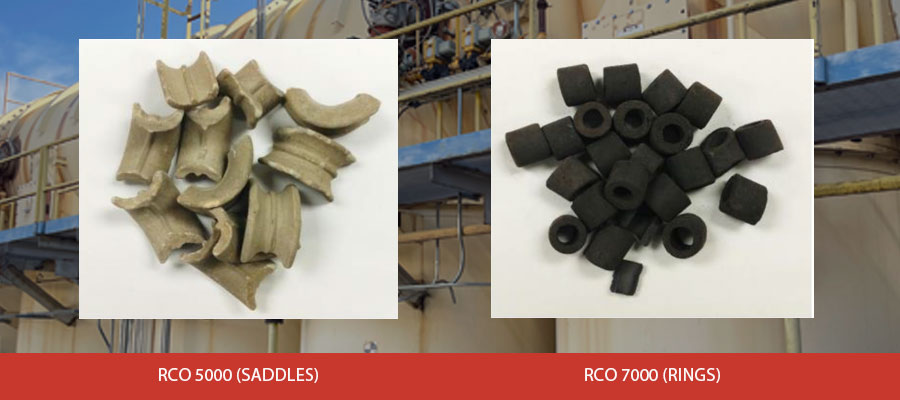
What equipment contained the catalyzed material that would be recycled?
Industrial catalysts are frequently found in equipment used to treat emissions from industrial processes used in manufacturing facilities across the U.S. Regenerative Catalytic Oxidizers (RCO) are a type of emission control equipment that uses PGM-bearing catalysts. RCOs are used for controlling VOCs (Volatile Organic Compounds) across a variety of industries.
- Pulp and paper
- Wood and board mills
- Coffee roasting
- Paint and coatings
- Specialty chemicals
- Others (see manufacturing page)
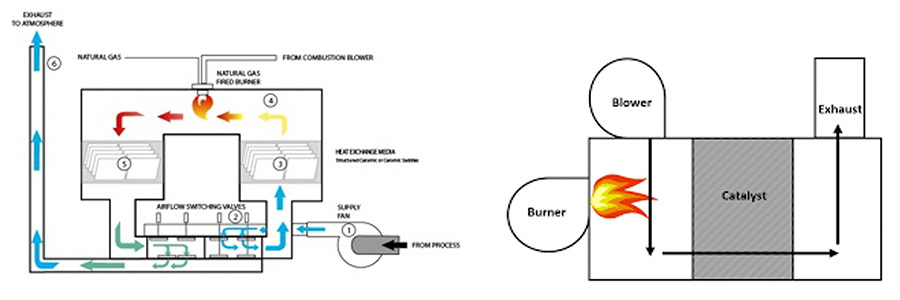
Regenerative Catalyst Oxidizer illustrations
Thermal oxidizers are the primary technology used to destroy volatile organic compounds (VOCs), hazardous air pollutants (HAPs), and to some degree, odor. These pollutants are discharged as a result of industrial processes and can be destroyed by oxidation at a high temperature. Thermal oxidizers achieve emission destruction through the process of thermal and catalytic oxidation to convert pollutants into carbon dioxide and water vapor while at the same time reusing the thermal energy to reduce operating costs.
Catalytic oxidizers are simply thermal oxidizers with an added catalyst that allow effective oxidation at a much lower temperature. In catalytic units, oxidation takes place on the surface of the catalyst.
What is the catalyzed media found in RCO equipment?
The catalyzed media is most often in the form of ceramic saddles, rings or balls coated with Platinum (Pt) or Palladium (Pd). The value of the PGM material varies depending on the catalyst loading, media type, and spot market prices for the PGM.
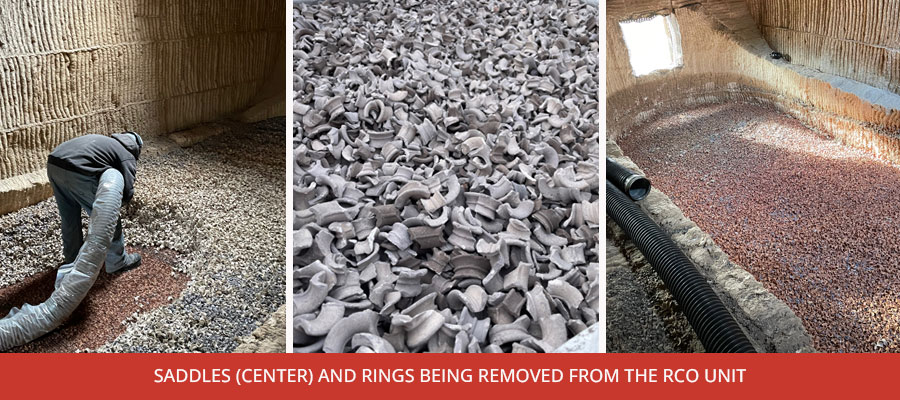
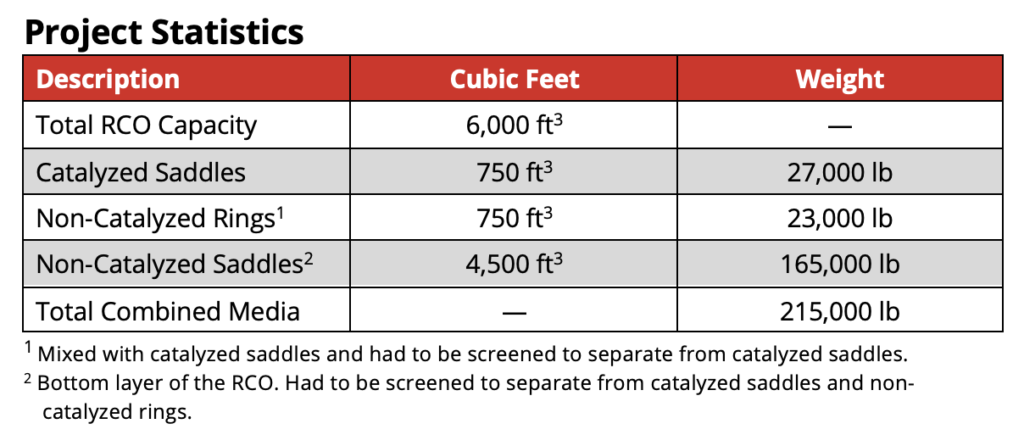
Did the plant owner originally plan to recycle the catalyzed media?
No. Unfortunately, most plant owners and demolition contractors don’t realize the value of these catalyzed materials. In this case, the plant owner was originally planning to pay for the dismantling and disposal of what they assumed was scrap material with little or no value. Fortunately, a specialty contractor recommended Red Fox Resources to help them evaluate their options. They ultimately decided to recycle the catalyzed material using Red Fox Resources.
What are the steps of a typical PGM recycling project?
- Analyze material samples to characterize and value the material.
- Estimate recoverable value, including transportation and processing costs.
- Provide quotation for services including logistics and transportation, assays and lot management, processing costs (per lb treated), and refining costs (per troy ounce recovered).
- Deliver and process material: Weigh, mill, blend, sample, and assay.
- Provide pro forma settlement showing results and costs.
- Sell metal and make payment to the plant owner.
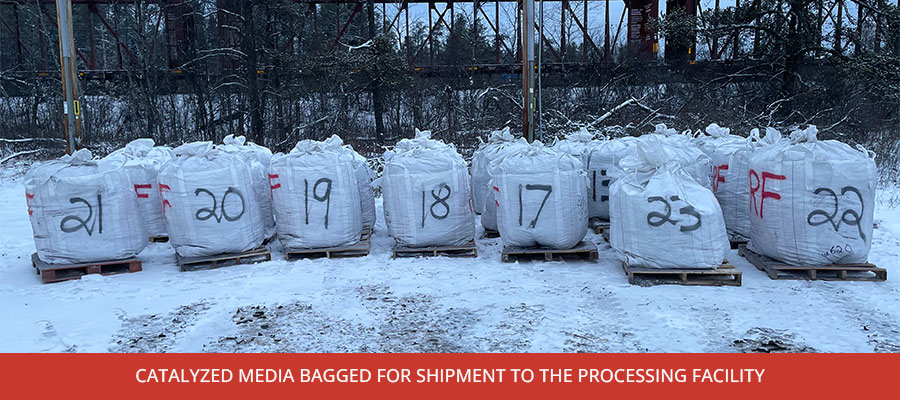
What were the risks for the plant owner trying to directly process their own PGM material?
With limited knowledge and experience with PGM recycling, there were many risks for the plant owner to proceed on their own.
- Not finding the right processor to handle their particular PGM material at reasonable costs.
- Not clearly understanding the terms and minimum concentration thresholds with processors.
- Not understanding the assay process and leveraging independent testing.
- Not understanding the best way to package, insure and transport the material.
- Not having an experienced broker to represent their interests throughout the process.
What were the benefits for the plant owner in working with Red Fox Resources to manage the process of recycling catalyzed material?
- A partner with extensive experience and knowledge of appropriate processors.
- A partner with extensive knowledge of appropriate terms, fees, and minimum concentrations.
- A partner with extensive experience with logistics, transportation, and relevant insurance.
- A partner with extensive knowledge of reputable labs and the assay process.
- Avoiding unexpected surprises related to meeting PGM lot minimums.
- An experienced partner that is continuously monitoring the market of service providers.
- Ensuring the maximum value is returned to the plant owner (i.e. client).
- Revenue is returned to the plant owner as opposed to disposal costs.
How long did this PGM recycling project take?
Overall, this project took three (3) months to complete. This included:
- Assessing and testing the material.
- Negotiating reasonable terms on behalf of the plant owner.
- Removing the material from the RCO equipment.
- Sorting and screening the material to separate the catalyzed material.
- Packaging the catalyzed material for processing and disposing of the non-catalyzed materials.
- Managing the logistics of shipping the catalyzed material to the processing facilities.
- Monitoring the various steps and overseeing a timely payout after processing.
What should other plant owners look for in selecting a PGM recycling partner to manage your project?
This is a very specialized field with limited options. Make sure your due diligence includes at least the following.
- Transparency, a clear term sheet, and an advocate at all points of the entire process.
- Verifiable experience with other PGM recycling or toll refining projects and client references.
- Knowledge of processing options, industry contacts, and industry norms.
- Knowledge of assay exchange processes and splitting limit norms.
- Knowledge of reputable independent labs and umpires.
- Logistics experience, including packaging, transportation, and insurance.
- No material moves without a fully executed term sheet
Get started with recycling your industrial catalysts
If you are interested in recycling scrap industrial catalysts or other emission control parts, please contact Red Fox Resources at www.redfoxresources.com or call 844-733-3695.

